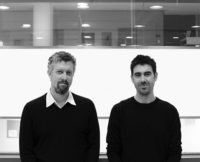As Emily abruzzo and Gerald Bodziak were mounting their installation Unmeasurability at the Rhode Island School of Design in 2015, a fire alarm prompted a security sweep of the gallery. Before escorting the architects out of the building, a guard walked to one of the construction’s five mirrored boxes, placed an eye to its arrowslit opening, and spent a few beats examining the infinitely reflecting grid within. The guard approved the project—the interior image is meant to symbolize the Internet’s seemingly endless expansion—with a simple “Oh, cool,” Abruzzo, 38, recalls with a smile. But the partners didn’t need verbal validation. “Someone immediately knew how to use our design and take delight from it,” she says.
As master of architecture students at Princeton, where they met in 2002, this moment did not seem inevitable. Coming of age alongside the rise of initiatives like the MoMA PS1 Young Architects Program or the Serpentine Pavilion, Bodziak, 39 says, “We felt a little disenfranchised by the culture of pop-ups.” Instead of speaking to an in-crowd of digitally savvy designers, “we wanted to get inside the heads of people who are not architects.” They earned their licenses and got married in 2008 and founded a Brooklyn-based studio the following year.
Reworking familiar forms is one way the architects connect to a wide audience. Their first executed commission, the 2012 Landscape (Triptych), installed at the Center for Architecture in New York, fashioned technical rope and electroluminescent wire into mountainous terrain that glowed at night like the neon signs of nearby storefronts. In a 2014 Manhattan apartment renovation, a razor-sharp plaster bevel sits above walls and millwork where crown molding would be expected. A proposed residence in rural Michigan takes the form of a barn morphed to suit 21st-century domestic life. “Architectural history and typology build understanding into a project,” Abruzzo says. “Something may resist categorization, but people will still have a sense of what they’re seeing.”
As their commissions grow in scale, the couple has begun combining typological reinvention with the appeal to intuition that so palpably moved that gallery security guard. For an overhaul of a single-family residence in Brooklyn, soon to start construction, they propose seating and planters embedded within the house’s masonry base to encourage outdoor use and neighborly interaction. The studio also is working through the concept phase of a new branch of the New York Public Library: daylight streaming through curved rooftop monitors will evoke the soaring arched windows of historic Carnegie libraries, while trapezoidal tables will accommodate both collaboration and traditional reading-room study.
“We have made an effort to move toward civic work,” Bodziak says of this latest project. A public building has to resonate with non-architects by its very definition. And Abruzzo and Bodziak are relishing the opportunity to fulfill everyday folks’ myriad demands. “A library is a cooling center, it’s a meeting spot, it’s a place where people can find information they don’t normally have access to. The program is inspiring.”
Abruzzo Bodziak Architects
FOUNDED: 2009
DESIGN STAFF: 4
PRINCIPALS: Emily Abruzzo and Gerald Bodziak
EDUCATION: Abruzzo: Princeton University, M.Arch., 2003; Columbia College, Columbia University, B.A., 2000. Bodziak: Princeton University, M.Arch., 2004; Taubman College of Architecture and Urban Planning, University of Michigan, B.S., 2000
WORK HISTORY: Abruzzo: Deborah Berke Partners, 2005–09; Balmori Associates, 2004–05. Bodziak: Gwathmey Siegel & Associates Architects, 2005–08; Morphosis Architects, 2001
KEY COMPLETED PROJECTS: Unmeasurability, Providence, 2015; exhibit design for FitNation, New York, 2013; Landscape (Triptych), New York, 2009
KEY CURRENT PROJECTS: New York Public Library Castle Hill Branch, New York, 2018; Greenpoint Wood House renovation and addition, Brooklyn, 2017









Post a comment to this article
Report Abusive Comment